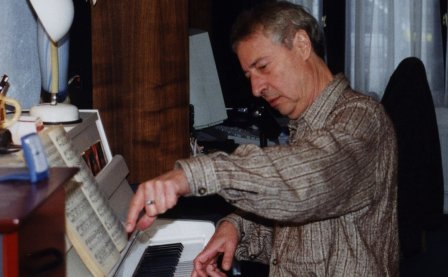In 1995 Jim O’Rourke was just 25, and he was already being referred to as “the da Vinci” of experimental music. God knows what that makes him now. The intervening 16 years have seen a famous and productive stint in Sonic Youth along with countless other all-star collaborations, a clutch of critically acclaimed solo albums, and an ever-expanding portfolio of film work (see here for the mind-bogglingly long list of credits). And even that, apparently, was only the merest tip of the O’Rourkean iceberg.
As if their street cred in the field of drone and experimental electronics needed any further cementing, back in April Austrian label Editions Mego (home to Fennesz, Hecker, Mark Fell, and Oneohtrix Point Never, among many illustrious others) announced a “nearly regular series of vinyl albums documenting analog synth and tape works (both studio and live) from the depths of Jim O’Rourke’s archive.” That series goes by the name of Old News. If you’re a real O’Rourke nut, the title will already be familiar to you. It began in 2002 as a series of cassette-and-CD-R-only releases put out in extremely low numbers while on tour in Japan and got as far as volume four before being picked up by the wise folks at Editions Mego. There are no plans at present to reissue the first four, meaning that we begin here with Old News #5.
And what a good way to start. The album collects together four recordings spanning nearly 20 years and right out of O’Rourke’s top experimental drawer. All 15 minutes plus, and with nary an acoustic instrument in sight: just synths and laptops. Sonically (if not necessarily in terms of artistic sensibility or approach), this is about as far away from 2009’s The Visitor as it gets. The decision not to proceed chronologically, moreover, was particularly smart. Whereas that might have tended to foreground the ‘documentary’ nature of the series or even encourage one to listen for signs of evolution or ‘progress,’ instead we’ve been given license to just listen. And the result is a record that stands alone as at least as worthy of attention as anything O’Rourke has yet produced.
It begins more or less in the present with “Pedal & Pedal,” 16 minutes’ worth of live recording from Tokyo’s esteemed SuperDeluxe only last year. It’s an exquisite track, right up there with O’Rourke’s very best output: a delicate, meandering and, for the most part, tonal work that sounds at once totally organic and absolutely not of this world. This, I like to imagine, is what pastoral music sounds like on Solaris.
From there, with “Detain the Man to Whom,” we’re brought immediately back down to the grubbiness of earth. Recorded in studio in 1992 — that is, barely a year after completing his formal music education at De Paul University and in striking contrast both to his orchestral work on Tamper and the trajectory he would soon embark on with Gastr del Sol — it’s a long, gentle clatter of a track. And what it seems to lack at first in terms of structure, repeated listens will soon yield at the level of texture.
“It’s Not His Room Anymore,” recorded in Tokyo again last year, is maybe the least pleasant of the four tracks on offer here. And by no means do I intend that as a criticism. In purely affective terms, it’s a creepy, unnerving listen, particularly once the demented, winding, oboe-like figure kicks in at around the seven-minute mark and sets to work on slithering its way under your skin.
Final track “Mother and Who,” by contrast, begins with a full-on assault on the senses before dissipating into a slow, throbbing series of eerie chord progressions that builds finally to a chirping, cathartic resolution. The fact that this was recorded in a year in which O’Rourke was (a) still playing and recording with Sonic Youth, (b) releasing Loose Fur’s debut record with Wilco’s Jeff Tweedy and Geoff Kotche, and (c) making his directorial debut at the Rotterdam Film Festival serves as yet another reminder of the breadth and extent of the man’s talent. Perhaps we should start calling da Vinci the O’Rourke of Renaissance art?
More about: Jim O'Rourke




